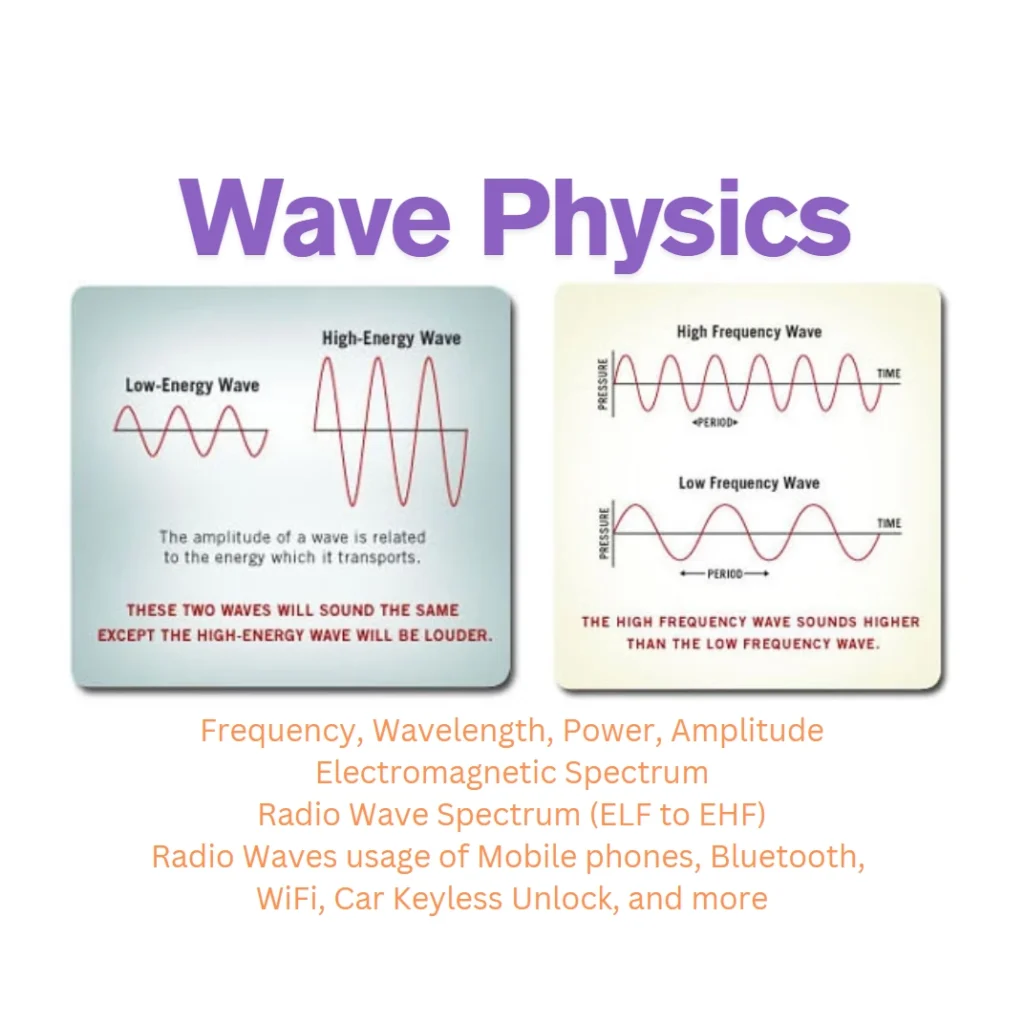High Frequency Waves have shorter wavelengths and vice-versa
Longer wavelength waves such as radio waves carry low energy; this is why we can listen to the radio without any harmful consequences. Shorter wavelength waves such as x-rays carry higher energy that can be hazardous to our health.
High frequency has short wavelength and it can be disturbed by the environment easily, but not true for all mediums. Low frequency has a long wavelength and it can diffract around an obstruction and can carry for a longer distance (again not true for all mediums). This is very similar to taking a straight wire and a coiled wire and trying to pass them through a hole. It is obviously easier to pass a straight wire than a coiled wire.
High frequency waves carry more data than a low frequency wave because the amount of data that can be transmitted, which is the bandwidth, is directly proportional to the frequency of the wave. A high frequency wave essentially has more shakes of the rope and can carry more data in the same time as compared to a low frequency wave. In short, longer wavelengths travel further but carry less information; shorter wavelengths have shorter ranges but can carry more information.
Longer wavelengths have lower frequencies; shorter wavelengths have higher frequencies. (For reference, Extremely Low Frequency (ELF) wavelengths are upwards of 100,000 km long and complete only a few, or even less than one, cycles per second, hence the “extremely low” frequency. Gamma rays are about one trillionth of a meter long (picometer) and complete upwards of 300 quintillion cycles per second. It’s a broad spectrum and all these waves travel at the speed of light (almost).
Spectrum of Radio Waves from Low Frequency to High Frequency
Wavelengths of radio waves can range from 1mm to 100km. A high frequency signal requires lower antenna length which is crucial to mobile phones. However, high frequency signals are more sensitive to reflection and will have a harder time passing through walls and obstructions. But, they can leak through holes of the size of the wavelength.
Frequency and power determine cell sizes
Higher frequencies (more Hertz) in the spectrum are capable of carrying more information per second than lower frequencies, but are not as reliable as lower frequencies over longer distances. So while higher frequencies can serve more customers per cell, those cells are smaller than cells using lower frequencies. This means that, as carriers use higher and higher portions of the spectrum (this will be important when we get to 5G), the cell size will decrease, resulting in more cells and more antennas. Cell size also depends on the power of the transmitter, so there can be smaller or larger cells for any given frequency band. Cells using small band must be quite small, since millimeter waves work best in short-distance, line-of-sight environments.
Power decreases by the square of distance as a signal radiates into space, the path loss also increases by the square of distance travelled. For example, if you transmit two signals of equal power, one at 1 GHz and a second signal at 2GHz, then the 2GHz signal will fade into the noise at a rate 4X faster (1/(2^2)) than the 1GHz signal, and will travel 1/4 as far before it fades into the noise.
For shorter-range wireless links, their maximum power is limited by the FCC, which helps prevent wireless systems from interfering with each other and with other systems using the same or similar parts of the spectrum. However, these shorter-range wireless technologies use unlicensed spectrum, so individual devices like your home router or your wireless headphones can operate anywhere without obtaining FCC permission first. Bluetooth uses a narrow band at 2.4GHz, while WiFi (the marketing name commonly used for a wireless local area network [WLAN], operating according to the IEEE 802.11 protocol) uses a few different bands. Near-field Communications (NFC) are similar, but even shorter range (usually only a few centimeters), and support things like contactless payment systems.
Radio Waves are modulated using AM and FM
Modulation is an electrical technique for imposing a piece of information, such as speech, music, an image, or data, on a radio-frequency carrier wave by changing one or more properties of the wave in response to an intelligence signal. Amplitude, frequency, phase, pulse sequence, and pulse length are the most regularly adjusted properties.
Radio signals are broadcast using AM (or Amplitude Modulation) and FM (or Frequency Modulation). Electromagnetic waves are used to transfer data in both cases. The amplitude of the signal or carrier delivered is modulated (changing) depending on the information being sent, but the frequency remains fixed. This is in contrast to FM technology, which encodes information (music) by altering the frequency of the wave while keeping the amplitude constant.
AM has a lower sound quality than FM, but it is less expensive and can be broadcast over longer areas. Because it has a smaller bandwidth, it can accommodate more stations in any frequency range. In comparison to AM, FM is less susceptible to interference. Physical impediments, on the other hand, have an influence on FM transmissions. The bandwidth allotted to an FM station is 150 kHz, which is 15 times that of an AM station. This explains why music sounds so much better on FM since an FM station can send 15 times as much information as an AM station.
Hope this is useful, thank you.
You may like to read: When your Teaching is not Interesting Enough!, Parts of a Computer – Explained!, and Best Home Tutors for Kids




